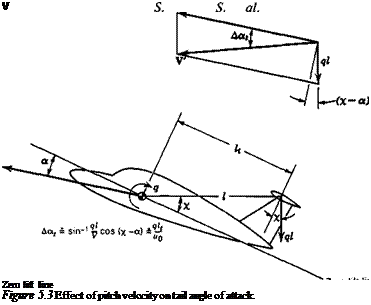CONTRIBUTIONS OF A TAIL
As illustrated in Fig. 5.3, the main effect of q on the tail is to increase its angle of attack by (ql,/u0) radians, where u0 is the flight speed. It is this change in a, that accounts for the changed forces on the tail. The assumption is implicit in the following derivations that the instantaneous forces on the tail correspond to its instantaneous angle of attack; i. e., no account is taken of the fact that it takes a finite time for the tail lift to build up to its steady-state value following a sudden change in q. (A method of including this refinement has been given by Tobak, 1954.) The derivatives obtained are therefore quasistatic.
Cz of the Tail
Zq
By definition, CZq = (dCzldq)0 = (2u0lc){bCzldq)0, and, from (5.1,1), (dCz/dq)0 = — (ЭCL/dq)0. The change in tail lift coefficient caused by the rotation q is
![]() ql,
ql,
AQ, = aJSa, = a, —
u0
 |
and the corresponding change in airplane lift coefficient is
|
|
|
![]() (5.4,2)
(5.4,2)
Cmq of the Tail
The increment in pitching moment that corresponds to AC/ ( is [see (2.2,9)]
Hence











